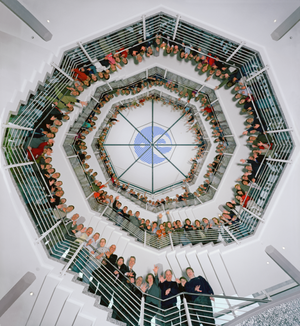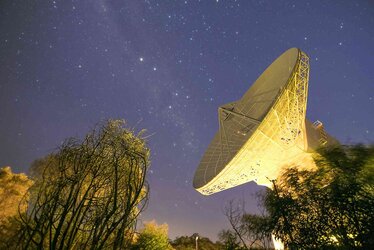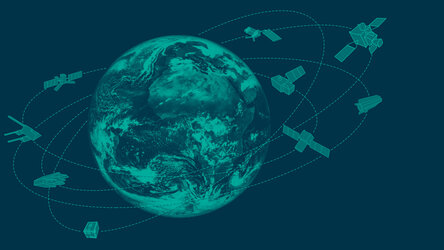The truth behind The Burn
ESA’s short film, The Burn, takes us into the heart of Europe’s mission control during a critical moment in the life of a future mission.
Filmed on site in Darmstadt, Germany, with the help of volunteers (many of which are real-life spacecraft controllers), The Burn illustrates the critical importance of decades of investment in state-of-the-art mission operations infrastructure and highly trained teams to flying Europe’s most daring space missions.
Synopsis


Access the video
SPOILER ALERT: This synopsis describes the plot in detail – watch the film before reading on
Set in 2029 at ESA’s mission control in Darmstadt, Germany, The Burn tells the story of a control team who seemingly lose a mission, as it fails to enter orbit around the Moon and drifts, rudderless, into deep space.
It all begins in the briefing room, as the team assembles to hear from the Spacecraft Operations Manager, or ‘SOM’, about the task before them. Their goal is to slow the spacecraft down by performing a single thruster burn, allowing it to be ‘captured’ by the Moon’s gravity and enter into a lunar orbit.
Unfortunately, this capture burn will take place as the spacecraft is behind the Moon, as seen from Earth, and is therefore out of contact with the control team.

“On console in 10 minutes”
The team take their positions in the Main Control Room, to begin the burn. The SOM is in constant communication with her team via the ‘voice loop’, as well as the flight dynamics experts in their dedicated room on-site, and ground station engineers at the New Norcia ground station in Western Australia.
The burn begins, and all goes to plan. As expected, the team lose contact with the spacecraft as it passes into the Moon’s shadow. They eagerly await the return of the signal as the spacecraft comes out the other side, but they hear nothing.
Engineers at the New Norcia ground station then report a signal coming and going, like a beacon. It must be that the spacecraft is spinning, unable to find Earth – for some reason it has entered survival mode.

Commands are sent to the spacecraft to stop it spinning, and fortunately it stabilises.
But what now for the capture burn? The flight dynamics team calculate new parameters to complete the burn, after the unexpected shut down that occured ‘in the dark’. But there’s a problem.
At this point they need an additional 20 minute burn to get back on track, but they don't have enough fuel. The team have missed the capture burn and failed to enter orbit – the spacecraft is now leaving the Moon and flying into deep space.
Surprisingly, the Operations Director, ‘OD’ congratulates the team. They have concluded their simulation, and will now work to find out how to avoid this situation for real. A solar flare struck the spacecraft as it was out of sight, blinding its two ‘star trackers’, meaning it no longer had any idea what direction it was facing.

They may have lost the simulated spacecraft, but this exercise means the real spacecraft is in safe hands, as they prepare in advance for every potential eventuality.
Generally simulations run for days on end before critical mission operations. These, combined with the most high-tech control rooms, up-to-date software systems and the largest deep space antenna network in Europe, mean they haven’t lost a mission yet.
So, what happened?

In this simulation, a very unlikely event took place: a solar flare knocked out both of the spacecraft’s star trackers. These are used to measure the position of stars in the sky and can act like a map, as the spacecraft uses this information to determine its orientation.
Without star trackers, such a spacecraft will typically still know where the Sun is (using its Sun sensors) as well as where Earth is with respect to the Sun – this angle is normally stored in its memory. However, it does not know its own position relative to Earth. Having lost its ‘fixed attitude reference’, it intentionally begins to spin.

Imagine a line between the Sun and Earth, the spacecraft begins to spin around that line. As it does so, its signal sweeps by Earth once during every rotation. On the ground, this appears as a beacon, and gives operators the information needed to stop the spacecraft spinning, just at the moment the antenna is pointing to Earth.
This strategy is normally used for spacecraft flying in deep space during normal operations, such as Juice, Solar Orbiter and BepiColombo. For relatively nearby spacecraft approaching the Moon, a failure like this would be unlikely to happen in reality.

Firstly, star trackers are normally only used when the spacecraft is steady - so stars can be observed - and not during a burn. Secondly, operators can use the so-called ‘omnidirectional’ antennas to maintain contact with the spacecraft in the unlikely scenario that it loses orientation.
However, the same failure in a deep space mission would involve long communication delays, so portraying this would make for quite a long, slow movie! As such, we decided to pick a problem that could happen in deep space, but applied to a nearby lunar mission.
Failures during ‘orbital injection’ are not uncommon. In 2003, the Japanese ‘Nozomi’ probe failed to enter Martian orbit due to damage caused to electronics by a solar flare.
In 1999, the Mars Climate Orbiter failed to enter orbit around Mars due to a mathematical error and in 2010, the Japanese Venus probe ‘Akatsuki’ failed to enter into a Venusian orbit due to technical problems with the propulsion system.














 Germany
Germany
 Austria
Austria
 Belgium
Belgium
 Denmark
Denmark
 Spain
Spain
 Estonia
Estonia
 Finland
Finland
 France
France
 Greece
Greece
 Hungary
Hungary
 Ireland
Ireland
 Italy
Italy
 Luxembourg
Luxembourg
 Norway
Norway
 The Netherlands
The Netherlands
 Poland
Poland
 Portugal
Portugal
 Czechia
Czechia
 Romania
Romania
 United Kingdom
United Kingdom
 Slovenia
Slovenia
 Sweden
Sweden
 Switzerland
Switzerland
































